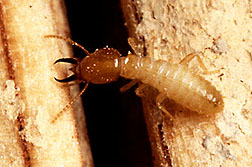This page has been archived and is being provided for reference purposes only. The page is no longer being updated, and therefore, links on the page may be invalid.
|
|
Environmentally Friendly and Effective Termiticide Available for Licensing From USDABy Amy SpillmanSeptember 9, 2002 A new weapon may soon be available to homeowners battling wood-eating foes, according to scientists at the Agricultural Research Service and the U.S. Forest Service. The weapon is a termiticide containing low concentrations of naphthalenic compounds; similar substances are also found in mothballs. The new product helps control both native Eastern subterranean and exotic Formosan subterranean termites and has proven effective in field tests in Mississippi and Louisiana. The effectiveness of the termiticide was tested by entomologists Guadalupe Rojas and Juan Morales-Ramos of ARS' Southern Regional Research Center (SRRC) in New Orleans, La., and microbiologist Frederick Green of the Forest Service's Forest Products Laboratory in Madison, Wis. Green has been researching naphthalenic compounds to determine if they can protect wood from fungal decay. He and others in the Forest Service are trying to find replacements for wood preservatives on the market containing heavy metals such as arsenic, chromium and copper. Through his research, he found that certain naphthalenic compounds not only prevented wood decay, but also killed native termite colonies. Green contacted Rojas and Morales at SRRC because of their experience in creating effective termiticides as part of Operation Full Stop, a USDA-led campaign to rein in the Formosan subterranean termite. The SRRC researchers were able to incorporate the naphthalenic compounds into a cellulose-based matrix--a toxic bait that termites like to eat and that is, consequently, more readily spread throughout their colonies. Right now, Formosan subterranean termites cost Americans about $1 billion per year in control and repair costs, and native termite species add another billion to that total. This new product should please consumers. It is environmentally friendly because it is effective in very low concentrations and contains no heavy metals. It is also cheap, costing only $1 per gram. Products currently on the market that deliver similar results can cost up to $50 per gram. A patent application has been filed, and the technology is available for licensing. ARS is the USDA's chief scientific research agency. |

